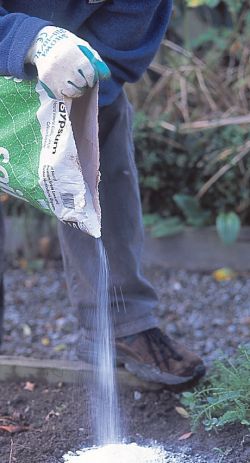Plant
Doctor Archive
 NPK
fertiliser NPK
fertiliser
 FOR
a long time I have been puzzled when comparing different packaged
fertilisers. Whilst I understand that the 8.3.6 (for example) shown
on a packet is the manufacturers' claimed percentage by weight of
N.P.K., how do I compare this with another brand that states 14.44.22?
I have two questions: FOR
a long time I have been puzzled when comparing different packaged
fertilisers. Whilst I understand that the 8.3.6 (for example) shown
on a packet is the manufacturers' claimed percentage by weight of
N.P.K., how do I compare this with another brand that states 14.44.22?
I have two questions:
1. Even the second example
only adds up to 40.9% - is the rest of the bag just a filler, apart
from minute quantities of trace elements?
2. The first example
adds up to 17% - does this mean it has less than half actual fertiliser
compared with the other brand. This is important when comparing
prices.
 THE
debate over fertiliser make-up is always a tricky one. The first
consideration is that the percentage of fertiliser in the bag is
made up by a weight count of European origins. THE
debate over fertiliser make-up is always a tricky one. The first
consideration is that the percentage of fertiliser in the bag is
made up by a weight count of European origins.
The N.P.K content listed
on the bag stands for Nitrogen, Phosphorus and Potassium. Therefore,
when comparing a fertiliser of N.P.K. 8.3.6 against one of 14.44.22,
you would say that there is a lot more nutrients in the higher one,
and therefore this may feed for a longer time, or give out a heavier
dose of fertiliser at over time.
Each of the three main
ingredients looks after different parts of the plants and their
function. The easiest way to judge their use is to think in terms
of Leaf (N), Root (P) and Fruit (K). A fertiliser of 8.3.6 will
be sufficient for the household gardener and will give a good balanced
feed to plants. The other fertiliser you mention may be used for
commercial purposes and will give good root growth to the plant
(P), and flowering/fruiting (K), with less emphasis on the foliage
growth.
As said before, fertiliser
is made up of mineral rocks and filler. The filler includes other
minerals that are important to how the fertiliser will work, how
the fertiliser will be taken up, and trace elements are usually
included. They are usually don't appear as a notation of percentage
on the bag as it is NPK make-up that you want to know.
Weekend
Gardener, Issue 105, 2002, Page 22
Reproduced with permission from the former Weekend Gardener magazine. The views expressed here are not necessarily those of the RNZIH.
|
 |
 |
|